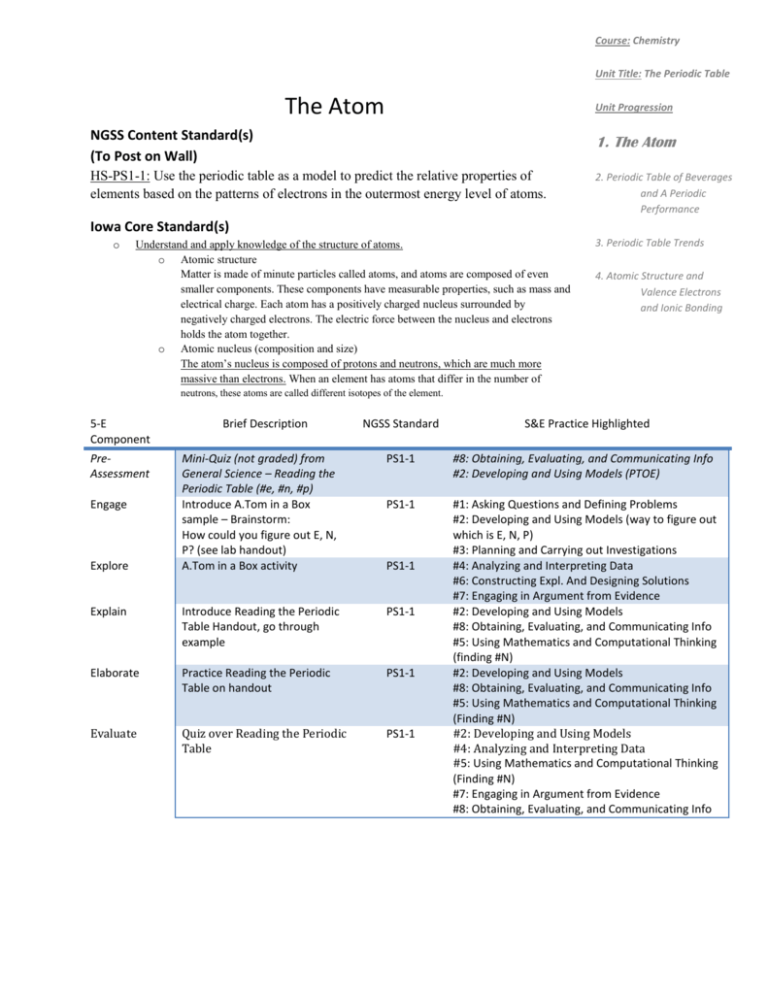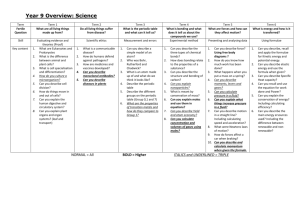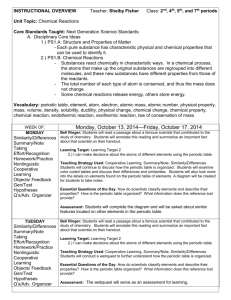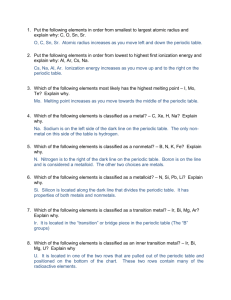PS1-1 The Atom - Science Teacher In Training
advertisement

Course: Chemistry Unit Title: The Periodic Table The Atom Unit Progression NGSS Content Standard(s) (To Post on Wall) 1. The Atom HS-PS1-1: Use the periodic table as a model to predict the relative properties of elements based on the patterns of electrons in the outermost energy level of atoms. 2. Periodic Table of Beverages and A Periodic Performance Iowa Core Standard(s) o Understand and apply knowledge of the structure of atoms. o Atomic structure Matter is made of minute particles called atoms, and atoms are composed of even smaller components. These components have measurable properties, such as mass and electrical charge. Each atom has a positively charged nucleus surrounded by negatively charged electrons. The electric force between the nucleus and electrons holds the atom together. o Atomic nucleus (composition and size) The atom’s nucleus is composed of protons and neutrons, which are much more massive than electrons. When an element has atoms that differ in the number of 3. Periodic Table Trends 4. Atomic Structure and Valence Electrons and Ionic Bonding neutrons, these atoms are called different isotopes of the element. 5-E Component PreAssessment Brief Description NGSS Standard S&E Practice Highlighted Mini-Quiz (not graded) from General Science – Reading the Periodic Table (#e, #n, #p) Introduce A.Tom in a Box sample – Brainstorm: How could you figure out E, N, P? (see lab handout) A.Tom in a Box activity PS1-1 #8: Obtaining, Evaluating, and Communicating Info #2: Developing and Using Models (PTOE) PS1-1 Explain Introduce Reading the Periodic Table Handout, go through example PS1-1 Elaborate Practice Reading the Periodic Table on handout PS1-1 Evaluate Quiz over Reading the Periodic Table PS1-1 #1: Asking Questions and Defining Problems #2: Developing and Using Models (way to figure out which is E, N, P) #3: Planning and Carrying out Investigations #4: Analyzing and Interpreting Data #6: Constructing Expl. And Designing Solutions #7: Engaging in Argument from Evidence #2: Developing and Using Models #8: Obtaining, Evaluating, and Communicating Info #5: Using Mathematics and Computational Thinking (finding #N) #2: Developing and Using Models #8: Obtaining, Evaluating, and Communicating Info #5: Using Mathematics and Computational Thinking (Finding #N) #2: Developing and Using Models #4: Analyzing and Interpreting Data #5: Using Mathematics and Computational Thinking (Finding #N) #7: Engaging in Argument from Evidence #8: Obtaining, Evaluating, and Communicating Info Engage Explore PS1-1







